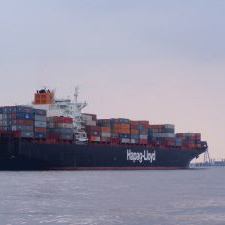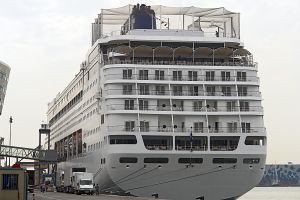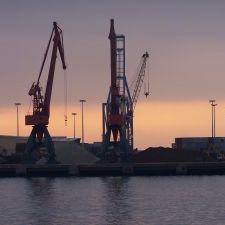 A 65-day cruise on aboard a cargo ship?
A 65-day cruise on aboard a cargo ship?
That’s so bananas … you belong on a banana boat!
OK, not all cargo ships are carrying bananas, but if you choose to take the “slow boat,” you may find yourselves among shipments of televisions, coal or even containers of mail.
And even in this “hurry up and get there” day and age, you may be surprised to learn that thousands of people travel this way each year.
As cargo ships sail between points to deliver products, sea-loving travelers are allowed to go along for the ride, often for dramatically less than what a traditional cruise might cost. Traveling via freighter can also be a rougher ride than a cruise ship, but if you’re cut out for it, you could be in for a big adventure.
“There used to be a time when there was no other way of traveling,” recalls Rankor Zunic, a Croatian sea captain who now operates the 15-year-old travel agency, Maris Freighter & Specialty Cruises. “I am an old sailor. I have been in the industry for 50 years, and we have always had passengers using freighters for cruises. It’s not as economical as flying, not as fast as flying, but people use them for vacations.”
Most cargo ships can accommodate up to 12 passengers, but that’s usually an exceptionally high number at any given time, explains Joycene Deel, who operates Freighter World Cruises, a Pasadena-based travel agency.
More likely, there will be just a few passengers, plus anywhere between 10-25 crew members and officers on board. A freighter voyage can take anywhere from several days to several months, and travelers can pay about $100 per day to join the trip (prices are often quoted in euros). While cargo ship travel is usually more expensive than air travel (in terms of getting to a destination), it is much more affordable when compared to traditional cruise ship travel.
Itineraries usually include far-off regions that would otherwise be difficult to cover in one continuous trip. For example, Freighter World Cruises offers an 84-day world cruise that starts off in Long Beach, California, and travels to Japan, South Korea, China, Taiwan, Hong Kong, and Singapore, then travels through the Suez Canal into Egypt, then Italy, Spain, back through the Suez Canal and into Malaysia, Hong Kong, China, Tokyo and finally back to Long Beach. All that for about $10,080, which breaks down to about $120 a day. Try getting that kind of itinerary on Carnival.
If the idea of being at sea for so long sounds daunting, there are shorter trips available. For example, Maris Freighter & Specialty Cruises offers Croatia’s Coastal Voyages, two-week roundtrip voyages on vintage vessels between Opatija and Dubrovnik, as well as a selection of one-week voyages on the Northern, Central and southern Adriatic.
 Depending on your expectations, climbing aboard a freighter may come as a bit of a surprise. The size of these ships can vary greatly, but they’re generally going to be much smaller than any standard cruise ship. Small freighters (which carry 1,000 or fewer containers) and are about 485 feet long, while large ships start at about 965 feet long. In comparison, Royal Caribbean’s Voyager of the Seas is about 1,020 feet long, accommodating about 3,000 passengers. Modern freighters are typically clean and comfortable with large cabins, and the exterior is usually pretty clean – however, there may be winches, cranes or other machinery (for loading and unloading) with exposed grease, so passengers are urged to dress casually.
Depending on your expectations, climbing aboard a freighter may come as a bit of a surprise. The size of these ships can vary greatly, but they’re generally going to be much smaller than any standard cruise ship. Small freighters (which carry 1,000 or fewer containers) and are about 485 feet long, while large ships start at about 965 feet long. In comparison, Royal Caribbean’s Voyager of the Seas is about 1,020 feet long, accommodating about 3,000 passengers. Modern freighters are typically clean and comfortable with large cabins, and the exterior is usually pretty clean – however, there may be winches, cranes or other machinery (for loading and unloading) with exposed grease, so passengers are urged to dress casually.
It’s important to keep in mind that traveling by freighter is more about the experience than the destination, and it can also be an exercise in independence. You may only be able to stop in ports for eight to 24 hours — and there’s no guarantee that you’ll even be there during daylight. A ship may arrive at midnight and depart the next day at 8 a.m., leaving you no time to see the city. Longer haul trips, especially around-the-world trips, tend to stop in ports for a few days at a time. Keep in mind that your port of call can change on a whim, based on weather conditions, port congestion or other factors.
If you’re planning on traveling by freighter, you need to have a relaxed, flexible attitude and schedule, as you may be dealing with unpredictable schedule changes like delays, extended trips and even skipped destinations. (If you’re truly a last-minute traveler, you might choose to hop aboard a “tramp ship,” which has no fixed schedule or port of call — the only problem is that you may get stuck in a port until the next tramp ship comes along.)
But even if you have some time to explore the area or if you’re planning on disembarking for good, the crew members will be working to unload the ship, so you’re pretty much on your own; in other words, it’s up to you to figure out transportation from the port and sights to see.
Your travel agency will mostly likely send you a list of expected ports, so it’s best to learn in advance how far the port is from the city center and what sort of transportation is available. For example, the French port Fos sur Mer is located a good 25 miles south of Marseilles.
 However, it is possible that you may run into unforeseen difficulties: take the case of Charlotte Phillips, a freight traveler who came across a shipping agent in Chiwan, China, who did not want her to go ashore. It was only after the captain vouched for her and she paid the agent a bribe that she was allowed to go ashore, with her valid 90-day visa in hand.
However, it is possible that you may run into unforeseen difficulties: take the case of Charlotte Phillips, a freight traveler who came across a shipping agent in Chiwan, China, who did not want her to go ashore. It was only after the captain vouched for her and she paid the agent a bribe that she was allowed to go ashore, with her valid 90-day visa in hand.
The good news is that modern freighters have come a long way in terms of comfort — particularly when it comes to basic amenities like food and accommodations. While some might imagine cramped sleeping quarters and watery gruel, the days of rough and tumble Viking ships are long gone. After all, the crew has to live here too!
Today’s freighters are generally spacious and clean, and rooms are comparable to that of the ship’s officers (think of a deluxe cruise ship room), with private bathrooms, a small refrigerator, a couch, table and desk, and even a steward to clean up after you. When it comes to food, your experience can be surprisingly good: Meals are prepared fresh, so really you just have to hope for the best when it comes to your chef’s cooking skills; don’t expect gourmet meals, though; you’ll probably be getting lots of meat and potatoes (not a lot of fruits and vegetables).
“It’s not good for a low-cholesterol or low-fat diet,” admits Deel. And while meal times vary based on the ship’s nationality, breakfast is usually served around 7:30 a.m., lunch at 11:30 a.m. and dinner at 5:30 p.m., plus coffee and tea. Although ships will usually let you take your meal in your room, check the rules first and don’t be late to the mess hall. You can also buy cigarettes and alcohol (and other items like toothpaste) on board – tax-free.
If you’re expecting your shipboard experience to include entertainment such as casinos and chorus lines, you’re better off calling up Carnival; freighters are working ships, and pleasure travelers may find themselves at sea for days on end with nothing more than a limited supply of books, DVDs and video games.
“There are no cocktail parties,” laughs Deel. “This is uninterrupted time to do things like read and write. We even had one lady bring her sewing machine on board, saying that this was finally her time to make her dining room curtains.”
Some ships have a small pool, sauna and/or gyms that are open for use, although one sea traveler recalls how the pool would occasionally be drained to make room for overflowing banana shipments (again, not something you would expect on Royal Caribbean!). So make sure you bring your own entertainment, whether it’s books, music, a laptop (there are electrical outlets, but check ahead of time to see if you need a converter), a deck of cards, or your latest arts and crafts project.
Beyond the extensive periods of peace and quiet you’ll get while traveling by cargo ship, one of the most attractive elements of these voyages for some can be the time you get to spend with the captain and crew. Those who enjoy conversation may be inspired by images of salty sea captains and boisterous crew members sharing bawdy stories over the dinner table.
While this could happen (you never know), chances are you’re more likely to simply strike up a good conversation; keep in mind that some crew members might not be on the chatty side, especially with civilians. The international sea language is English, but since the ships’ crews tend to be Eastern European or Filipino in origin, “American English” probably won’t be the norm. And for those looking for an interactive experience, keep in mind that passengers are not allowed to work on the ship alongside the crew.
Most cargo ships have an upper age limit of 79-82, and require that each passenger have a statement of good health signed by their physician.
“A person must be in good condition because there is no doctor on board,” says Zunic, who explains that there have been times when crew members have had to play doctor while at sea. “We sailors take care of ourselves. There is a small hospital room with a bed, and we have instruments and medicine. We can call a doctor from the middle of the ocean and in an emergency, you do what you have to do.” But, he assures, “That rarely happens.”
The most important thing is to make sure you’re in good health before you board, and that any existing conditions or medications are manageable and under control. Also remember that these ships aren’t handicapped accessible, and they often require climbing steep flights of stairs. Cargo ships don’t have stabilizers, either, so there is the likelihood of getting seasick, especially as you’re developing your “sea legs.” Larger tend to have smoother rides.
While traveling by sea may sound like a tribute to days gone by, there are still some modern issues like visas and immunizations that you need to deal with before you go. For example, China requires a visa from travelers arriving by ship, but Hong Kong does not. No immunizations are required for travel between the U.S. and Europe, Canada and Australia, but if you’re traveling through the Panama or Suez Canals, you’ll need shots for yellow fever/malaria and cholera. Fortunately, since you’ll have to book your trip through a travel agent, they can help you deal with all of these specifics (and more) based on your port of call.
There are several travel agents that specialize in booking freighter travel:
Maris Freighter & Specialty Cruises
1-800-99-Maris
www.freightercruises.com
Freighter World Cruises
800-531-7774
www.freighterworld.com
TravLtips
800-872-8584
www.travltips.com
For travel blogs and personal Web pages on freighter trips, you can visit www.freightertrips.com/voyages/index.html
By Managing Editor Sarika Chawla for PeterGreenberg.com
Want more cheap ways to travel?
Save Money By Cutting Bills While You Vacation
How to Find Cheap International Flights
Or try Looking Into the Fare Future. . .












